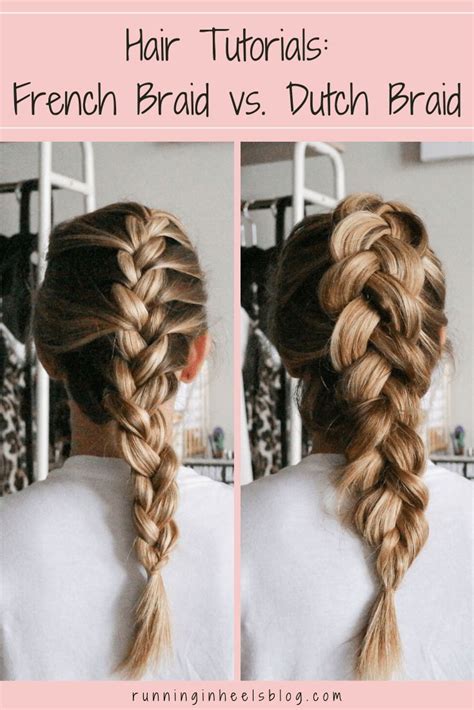Introduction
Braids have been a timeless style for centuries, adding a touch of elegance and versatility to any look. Among the myriad of braiding techniques, French and Dutch braids stand out. Both intricate and eye-catching, each braid boasts unique characteristics that cater to different styles and preferences.

This comprehensive guide delves into the nuances of French and Dutch braids, exploring their differences, applications, and how to achieve these captivating hairstyles effortlessly. Whether you’re a seasoned braiding enthusiast or a novice seeking to expand your repertoire, this ultimate braid-off will empower you with all the knowledge you need.
French Braids: Underhanded Allure
Definition
French braids, also known as classic braids or three-strand braids, are created by crossing three strands of hair over and under one another, gradually adding new hair to the braid as you progress. Known for their elegant and intricate appearance, French braids are a versatile choice for any occasion.
Distinctive Features
- Begin by dividing hair into three equal strands.
- Cross the right strand over the middle strand, then the left strand over the new middle strand.
- Repeat this process, continuously adding small sections of hair from the sides of the head to the outer strands.
- Secure the braid with a hair tie or ribbon.
Advantages and Disadvantages
Pros:
- Effortless and timeless style
- Suitable for all hair types and lengths
- Can be dressed up or down
- French braid pigtails are a cute and practical option for children
Cons:
- May be more time-consuming than other braids
- Can appear less voluminous than other braiding techniques
Dutch Braids: Overhanded Appeal
Definition
Dutch braids, also referred to as inside-out braids or inverted braids, are similar to French braids but with a fundamental difference in the crossing technique. Instead of crossing the strands over one another, Dutch braids involve crossing the strands underneath, creating a raised and more voluminous effect.
Distinctive Features
- Divide hair into three equal strands.
- Cross the right strand under the middle strand, then the left strand under the new middle strand.
- Continue this process, continuously adding small sections of hair from the sides of the head to the outer strands.
- Secure the braid with a hair tie or ribbon.
Advantages and Disadvantages
Pros:
- Create a bold and eye-catching look
- Ideal for adding volume to fine hair
- Suitable for a wide range of hairstyles
- Dutch braids crown can be worn as a beautiful headpiece
Cons:
- Can be more challenging to master than French braids
- May be less comfortable for long periods of time
- Dutch braid buns may require bobby pins to secure them
Applications: Endless Braiding Possibilities
Both French and Dutch braids offer a multitude of styling options, allowing you to customize your look and express your creativity.
-
Everyday Elegance: Wear a French braid down for a casual and chic look or opt for a sleek Dutch braid for a more polished appearance.
-
Formal Occasions: French and Dutch braids can elevate any formal ensemble, adding an air of sophistication to weddings, proms, and other special events.
-
Active Lifestyles: Braids are a practical and stylish choice for athletes or anyone engaged in physical activities, keeping hair out of the way while preventing tangles.
-
Protective Styles: Braids can be used as protective hairstyles, minimizing hair breakage and tangles, especially for those with natural hair textures.
-
Hair Accessories: Enhance your braids with hair accessories such as ribbons, beads, or clips to add a touch of glamour or match your outfit.
Common Mistakes to Avoid
To ensure your French or Dutch braids turn out flawless, steer clear of these common pitfalls:
- Not securing the base: Ensure the braid is tightly secured at the crown to prevent it from falling apart.
- Pulling too tightly: Avoid braiding too tightly, as this can cause discomfort and damage hair.
- Inconsistent tension: Maintain even tension throughout the braid to prevent sections from appearing loose or uneven.
- Over-braiding: Avoid braiding your hair too often, as it can lead to breakage.
- Not moisturizing: Keep your hair hydrated to prevent dryness and tangles while braiding.
Effective Strategies: Master the Art of Braiding
Elevate your braiding skills with these practical tips:
- Practice makes perfect: The more you practice, the easier it will become to create flawless braids.
- Section your hair: Dividing your hair into smaller sections makes the braiding process more manageable.
- Use a mirror: Use a mirror to ensure that your braids are even and symmetrical.
- Don’t be afraid to experiment: Try different braiding patterns and techniques to find what suits you best.
- Accessorize your braids: Add a personal touch to your braids with accessories.
Comparison: French vs Dutch Braids
To help you make an informed decision, here’s a side-by-side comparison of French and Dutch braids:
| Feature | French Braid | Dutch Braid |
|---|---|---|
| Appearance | Intricate, elegant | Bold, voluminous |
| Technique | Cross strands over | Cross strands under |
| Hair Types | Suitable for all | Ideal for fine hair |
| Styling Options | Versatile | Varied, adds volume |
| Effort Level | Moderate | Challenging |
| Comfort Level | Comfortable | May be less comfortable |
Conclusion
Whether you prefer the classic elegance of a French braid or the bold volume of a Dutch braid, both braiding techniques offer a timeless and versatile way to elevate your style. By mastering the techniques, avoiding common mistakes, and experimenting with different strategies, you can effortlessly create stunning braids that will turn heads wherever you go. Embrace the versatility of French and Dutch braids and let your creativity shine through!
